
Pieris is a genus of seven species of shrubs in the flowering plant family Ericaceae, native to mountain regions of eastern and southern Asia, eastern North America and Cuba. Known commonly in North America as andromedas or fetterbushes, they are broad-leaved evergreen shrubs growing to 1–6 metres tall and 3–10 ft (0.9–3.0 m) wide. The leaves are spirally arranged, often appearing to be in whorls at the end of each shoot with bare stretches of shoot below; they are lanceolate-ovate, 2–10 cm (0.8–3.9 in) long and 1.0–3.5 cm (0.4–1.4 in) broad, leathery textured, and with an entire or serrated margin. The young leaves in spring are typically brightly coloured. The flowers, which may have a very appealing honey scent, are bell-shaped, 5–15 mm (0.2–0.6 in) long, white or pink, and arranged in racemes 5–12 cm (2.0–4.7 in) long. The fruit is a woody capsule which splits into five sections to release the numerous small seeds.
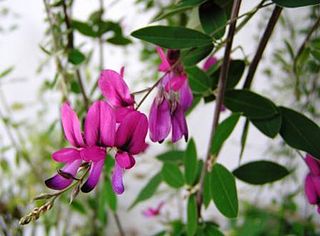
Lespedeza is a genus of some 45 species of flowering plants in the pea family (Fabaceae), commonly known as bush clovers or Japanese clovers (hagi). The genus is native to warm temperate to subtropical regions of eastern North America, eastern and southern Asia and Australasia.
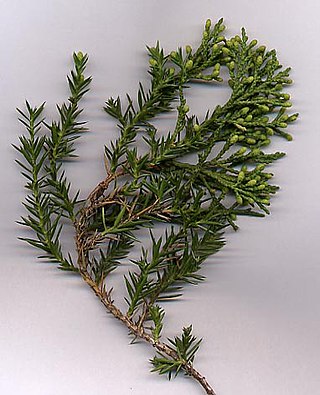
Juniperus chinensis, the Chinese juniper is a species of plant in the cypress family Cupressaceae, native to China, Myanmar, Japan, Korea and the Russian Far East. Growing 1–20 metres tall, it is a very variable coniferous evergreen tree or shrub.

Elaeagnus, silverberry or oleaster, is a genus of about 50–70 species of flowering plants in the family Elaeagnaceae.

Kerria japonica, commonly known as Japanese kerria or Japanese rose, is a deciduous, yellow-flowering shrub in the rose family (Rosaceae), native to China, Japan and Korea. It is the only species in the genus Kerria. In the wild, it grows in thickets on mountain slopes. Japanese kerria has been used for medicine and is also planted in gardens. A double-flowered cultivar, K. japonica 'Pleniflora', is commonly called bachelor's buttons.
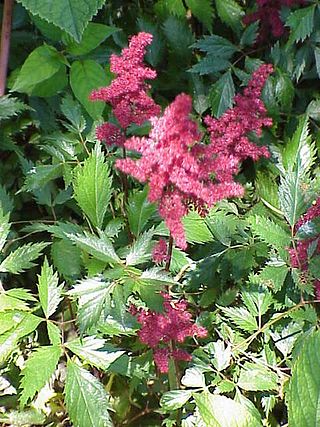
Astilbe is a genus of 18 species of rhizomatous flowering plants within the family Saxifragaceae, native to mountain ravines and woodlands in Asia and North America. Some species are known by the common names false goat's beard and false spirea.
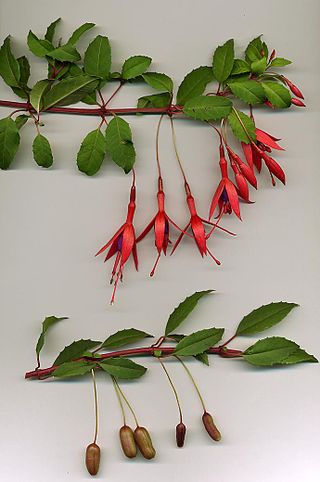
Fuchsia magellanica – commonly known as the hummingbird fuchsia, hardy fuchsia or chilco – is a species of flowering plant in the evening primrose family Onagraceae, native to the lower Southern Cone of southern South America.

× Fatshedera is hybrid genus of flowering plants, common name tree ivy or aralia ivy. It has only one species, × Fatshedera lizei. The hybrid symbol × in front of the name indicates that this is an inter-generic hybrid, a cross between plants from different genera. The name may be displayed with or without a space after the × symbol.

Fatsia japonica, also fatsi, paperplant, false castor oil plant, or Japanese aralia, is a species of flowering plant in the family Araliaceae, native to southern Japan and southern Korea.

The Ishikawa Forest Experiment Station is an arboretum and botanical garden located at Ho-1 Banchi, Sannomiya-machi, Hakusan, Ishikawa, Japan. It is open daily; admission is free.

Spiraea japonica, the Japanese meadowsweet or Japanese spiraea, is a plant in the family Rosaceae.

The term "Japanese iris" encompasses three species of Irises cultivated in gardens or growing wild in Japan: hanashōbu, kakitsubata and ayame. Of these three species, I. ensata is the one most commonly referred to as "Japanese iris" outside Japan.

Aucuba japonica, commonly called spotted laurel, Japanese laurel, Japanese aucuba or gold dust plant (U.S.), is a shrub native to rich forest soils of moist valleys, thickets, by streams and near shaded moist rocks in China, Korea, and Japan. This is the species of Aucuba commonly seen in gardens - often in variegated form. The leaves are opposite, broad lanceolate, 5–8 cm (2.0–3.1 in) long and 2–5 cm (0.79–1.97 in) wide. Aucuba japonica are dioecious. The flowers are small, 4–8 mm (0.16–0.31 in) diameter, each with four purplish-brown petals; they are produced in clusters of 10-30 in a loose cyme. The fruit is a red drupe approximately 1 cm (0.39 in) in diameter that is avoided by birds.

Berberis japonica is a species of flowering plant in the family Berberidaceae, native to Taiwan. Despite the name, it is not native to Japan, though it has been known in cultivation there for centuries. The wild origins of this species have long puzzled botanists, but wild plants in Taiwan, previously known under the name Mahonia tikushiensis, appear most similar to the cultivated forms of B. japonica.
Berberis × hortensis is an interspecific hybrid shrub. Its parents are Berberis oiwakensis and Berberis japonica. It was raised in gardens during the 20th century, and has become an important garden and landscape plant.

Stachyurus praecox, early stachyurus, is a species of flowering plant in the family Stachyuraceae, native to Japan. It is a spreading deciduous shrub growing to 4 m (13 ft) tall by 3 m (10 ft) wide. Pendent, bell-shaped, primrose yellow flowers are borne on naked arching branches in winter and spring. They are followed by ovate leaves, which colour to pink or red before falling in autumn.

Eriocapitella is a genus of flowering plants in the buttercup family Ranunculaceae. Plants of the genus are native to Asia. The generic name Eriocapitella roughly translates to "growing in a small woolly head", which refers to the hairy ovary and fruit of some members of the genus. Cultivated plants are commonly known as fall-blooming anemones.

Eriocapitella japonica is a species of flowering plant in the buttercup family Ranunculaceae. The specific epithet japonica means "from Japan", which is a misnomer since the species is introduced in Japan. It is native to China, Taiwan, and Vietnam.
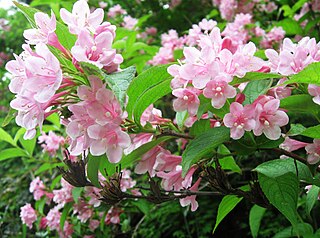
Weigela hortensis is a species of flowering plant in the family Caprifoliaceae, native to Hokkaido and Honshu islands of Japan. A rounded shrub reaching 10 ft (3 m), and hardy in USDA zones 6 through 9, it is occasionally found in commerce.
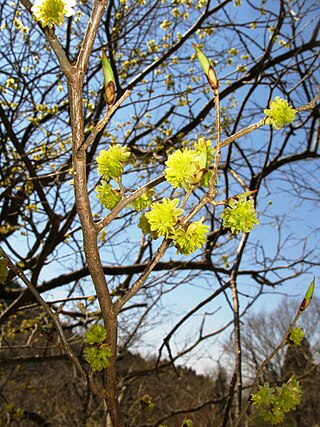
Lindera praecox, the February spicebush, is a species of flowering plant in the family Lauraceae, native to southern China, and Japan. A deciduous shrub typically 4.5 to 7.5 m tall, it is hardy to USDA Zone 8. In the wild it is found in thickets on the slopes of hills and mountains, and on the banks of streams and lakes. It is occasionally available from specialty nurseries.























